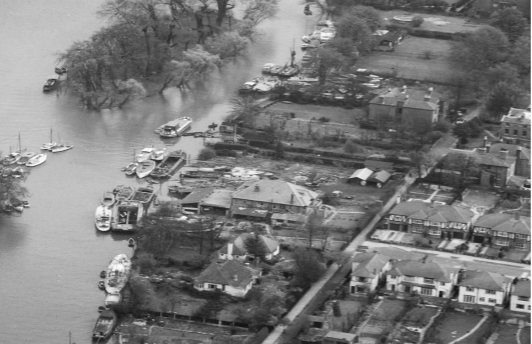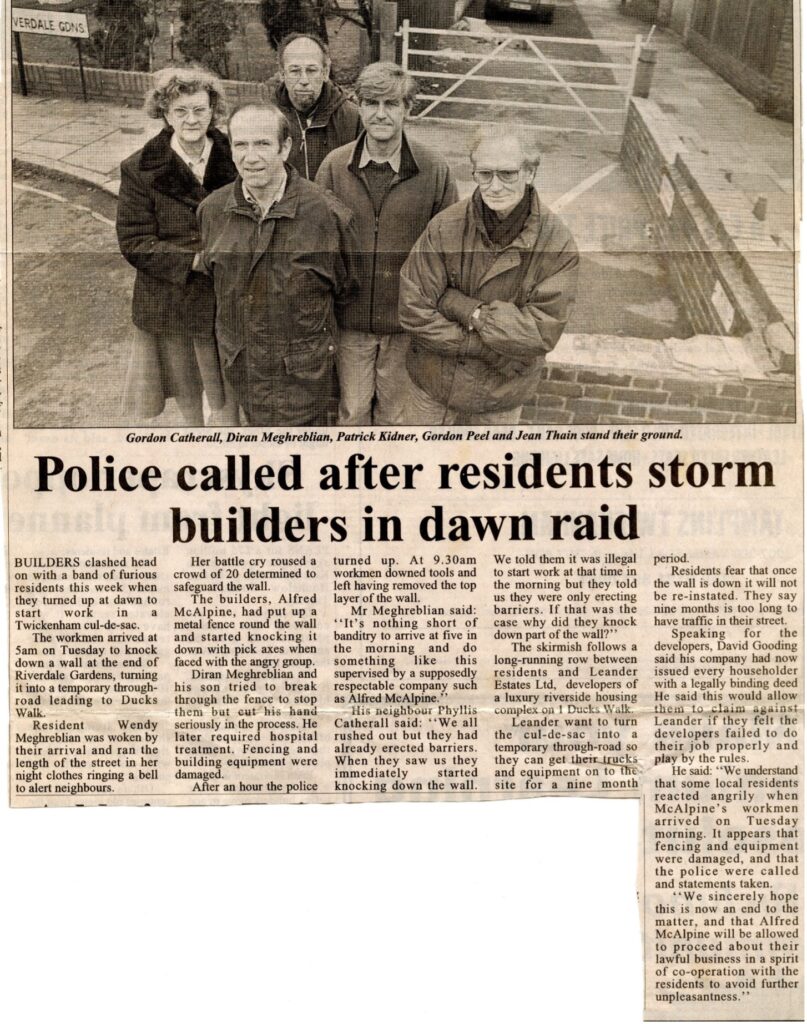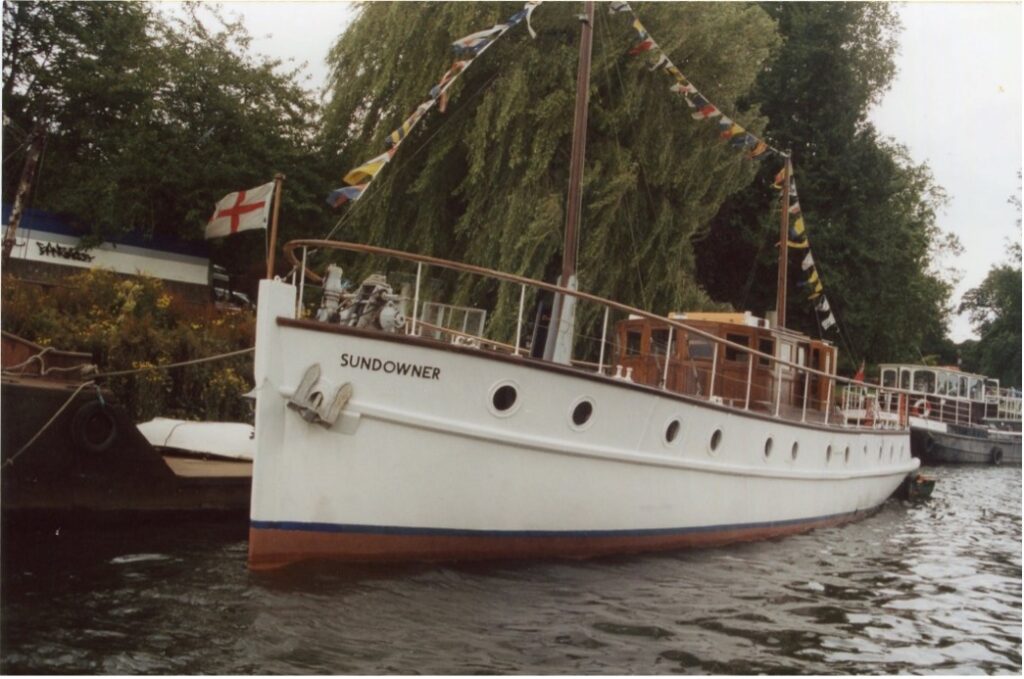No 1 Ducks Walk

The Original Building
According to local records, the area known as 1 Ducks Walk was originally part of Twickenham Park Estate. The boathouse was the first building on the site, initially shown in the Ordnance Survey map of 1935 so probably constructed during the 1920s. As indicated by the photo above, the site was a working boatyard at that time, with several lighters and small craft moored alongside. The boathouse survived there until its demolition in the year 2000.

Since its original purchase, the site has undergone several changes of ownership and use. While the boathouse occupied the site, it provided accommodation for the owner as well as facilities for constructing motor launches, speedboats and other small craft. However, the size of the site and its location presented developers with an attractive opportunity. Numerous attempts were made from at least 1972 to obtain permission for demolition of the boathouse and its replacement with housing or business uses. Until Leander Estates successful application in 1997, all of these were refused by Richmond Council, often with backing from residents and groups with riparian interests.
When in 1996, Cala Homes Ltd applied to replace the boathouse with a block of 14 flats and a new boathouse, local opposition was galvanized. With the support of the Environment Trust for Richmond upon Thames (later incorporated in Habitats and Heritage), several local groups[1] joined together as the Ducks Walk Boathouse Project (DWBP) and sought to oppose the application. Their efforts were successful when, in March 1997, the application was refused after a three-day public enquiry.
[1] 14th Richmond Sea Scouts, The Great River Race, Richmond Bridge Boathouses, Thames Traditional Boat Society, British Trust for Conservation Volunteers, and the River Thames Boat Project.
The following September, another company – Leander Estates – placed a different application before the Council, seeking to replace the boathouse with four large houses. Residents were consulted and opinions were divided although many objected to the scale of the buildings and some to the lack of river-related uses. The Environment Trust and DWBP continued to campaign in favour of the latter and for greater public access to the site in line with its previous use. By contrast, residents in Park Road wrote to the Press and Richmond Council broadly in support of the developers’ aims. Both local and regional press became involved, especially after the revelation that the site had once been owned by Commander Charles Lightoller, the senior surviving officer in the Titanic disaster (see below for further details).
To strengthen their case, the DWBP applied to the Council for planning permission to build a boathouse for community use on a small part of the site upstream. Their intention was to put pressure on the developer to limit the scale of housing on the remaining area and to give wider publicity to the need for riparian infrastructure. Planning permission was duly obtained in April 1999 but only four months later, Leander Estates succeeded in their own application for development of the entire site. By now their plans included a marina, new slipway, and a small boathouse as ‘community benefit’, situated beside the Riverdale Gardens cul de sac.
The Wall Dispute
Permission to demolish the original boathouse was finally given on 5th January 2000 but by this stage, residents in Riverdale Gardens had been alerted to the possibility that the road would be used for access to the site by contractors. Many felt that such a temporary arrangement might be deemed to justify permanent access at a later stage, and this led to widespread publicity about the controversy both in the local and regional press. Not surprisingly, opposition came largely from Riverdale Gardens whilst Park Road residents were more supportive of the developer’s plans.
With the help of a solicitor, worrried residents in Riverdale Gardens sought a formal agreement with Leander Estates to replace the cul de sac wall after completion of works on the site. Knowing that ownership of the wall had never been clearly establiished, they maintained a daily watch from October 1999, suspecting the contractors would turn up at any time to demolish it. In the absence of any agreement, the vigil was extended to include nightime hours for about two weeks. It was not unexpected therefore when, at about 5.00am on Tuesday 11th January, the contractor’s arrived to start work, accompanied by the developer’s solicitor. Under cover of darkness, they began to surround the wall with barriers but the noise alerted a neighbour who immediately rang her bell to summon the support of others in the road. A scuffle ensued as residents attempted to prevent the wall being destroyed. Eventually the police were summoned and the contractors agreed to suspend their activity until a legally binding agreement had been made.

It was not until 18th January that a restrictive covenant was signed by Leander Estates and residents, ensuring the cul de sac would be re-instated on completion of the works. In other negotiations with the Council, the developer agreed to provide a public footpath giving access to the river beside the boathouse and along the whole frontage of the site. The aim at that time was to provide a continuous footpath along the river, all the way to Richmond Bridge.[2]
[2] This has never been achieved but the footpath to the river and along the front of the site remains open to the public to this day.
Following these events, the developer was free to demolish the wall and begin construction on the site. The works there continued until completion and the cul de sac wall was re-instated as agreed. On a sunny afternoon in July 2002, the Sea Cadet Boathouse was officially opened by their Admiral, Prince Andrew, with much fanfare and in the hope that it would be a centre of activity in future years. Sadly this has never been realised and to this day, the building has been under-used while the Sea Cadets continue to operate from their main centre on the Old Deer Park. Since they have an exclusive 99 year lease on the Ducks Walk facility, it’s unlikely this arrangement will change in the foreseeable future.


The Lightoller Story
During the debate about potential uses of the site from 1997 onwards, the importance of its history and its relevance for publicity became clear to all involved. Amongst the details which emerged at that time, the story of a previous owner – Commander Charles Lightoller – featured prominently. Popularly known as Lights, he acquired the site after the end of World War 2 and lived there in the boathouse with his wife Sylvia until his death during the Great London Smog in December 1952. There are many books and articles about his life which was remarkable, not only for his contribution in the Titanic disaster but also for his role in both World Wars. For a comprehensive summary of his life – warts and all – it’s worth reading the Wikipedia entry here: https://en.wikipedia.org/wiki/Charles_Lightoller
Details about his tenure of 1 Ducks Walk have been difficult to uncover although it’s known that he constructed Motor Launches for the Admiralty and River Police with the help of his son Trevor, a former Colonel in the Royal Signals. His own motor yacht Sundowner which he memorably took to Dunkirk in 1940 was berthed there and remained after his death, often used by his widow Sylvia. Bernard Westwood who worked at the boatyard as an apprentice in the early 1950s recalled helping to build Richmond Sparrow, a mahogany boat exhibited at the first London Boatshow in 1952, as well as other craft for Norman Wisdom and Michael Bentine.[3] Rumors that Lightoller also constructed replica lifeboats for the Titanic film a Night to Remember have circulated widely. However, he died about six years before the film was completed. So it seems unlikely although it’s possible the replicas were built at the yard during its subsequent tenure by his son and widow who continued to live there for several years after his death.
[3] Quoted in the Richmond and Twickenham Times 27th March 1998.
The Lightoller Plaque
The idea of giving Lightoller a special place in Twickenham’s history emerged during residents’ meetings about the development. How might his legacy be used to promote river-related activity there, and what form should it take? It was readily agreed that a plaque should be designed and ideally located on the site where he had lived and worked. The Twickenham Park Residents’ Association supported the idea and agreed to pay for the plaque. Contact was established with members of the Lightoller family so they could play a part in the project. Amongst those who expressed interest was Tim Lightoller, grandson of Charles and a former Commander of nuclear submarines. The wording of the plaque was agreed between him and several residents, one of whom created the design on his computer. The plaque was constructed by a Graphic Design company in Crown Road.

Following negotiations between Richmond Council, TPRA , and DWBP, it was agreed the plaque should be presented to the Borough at a regatta to be staged at Buccleuch Gardens in July 2002. To mark the occasion, Sundowner wasbrought back to Richmond by its owners, the Ramsgate Maritime Museum, and moored beside the site so visitors could go aboard. Several members of the Lightoller family attended the event where the TPRA Chairman, Derek Mitchell, presented the plaque to the Mayor of Richmond, Councillor Doug Orchard.


The plaque still stands at the end of Riverdale Gardens beside the disputed wall. Many would have preferred to locate it on the other side of Ducks Walk in front of the boathouse, on the site which Lightoller himself had owned. However, despite their expressed wish to mark his legacy, Leander Estates refused to give permission.
Many thanks for this History by Patrick Kidner, April 2023.
Leave a Reply